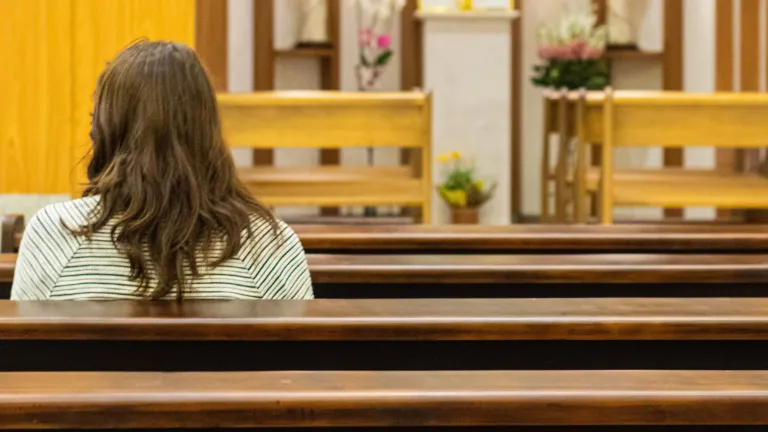Walking With God: The Truth About Easter and Passover

What do colored Easter eggs, rabbits and sunrise services have to do with Jesus Christ?
While millions assume these customs are Christian, nowhere in the Bible are they found being practiced by the Church Jesus founded. If Easter and its traditions don’t come from Holy Scripture, where did they originate?
They in fact emerged from ancient paganism. The English word Easter is derived from the Old English term Eostre or Ostara, the name of the goddess of the spring, the dawn and fertility. Over 1,000 years before the birth of Jesus Christ, pagan people reveled in festivals to this and other pagan gods and goddesses that included sex rituals and even orgies. These festivities occurred around the time of the spring equinox when the sun’s rays brought warmth and life to the earth following the cold and darkness of winter.
Easter and its customs have pagan roots
In pagan cultures, eggs often symbolized fertility and reproduction. For example, the ancient Druids in Britain and Gaul (modern-day France), were said to dye eggs and bury them in the newly plowed fields in late winter to encourage fertility and prosperity. As to the Easter bunny, in ancient times rabbits, as a rapidly breeding mammal, were valued as a sign of producing offspring. In addition, the Easter sunrise service has roots in the pagan ritual of prostrating before the rising sun (see Ezekiel 8:16).
How did Easter and its customs become infused into traditional Christianity? It was due to the rise of misguided, compromising teachers who appropriated heathen spring rituals and deceptively applied them to Christ’s resurrection (Matthew 24:4-5; Colossians 2:8; Deuteronomy 12:30-32).
Vine’s Complete Expository Dictionary of Old and New Testament Words states that Easter was “introduced into the apostate Western religion, as part of the attempt to adapt pagan festivals to Christianity” (1985, “Easter,” pp. 344-345, emphasis added throughout).
Also, author James Frazer wrote: “When we reflect how often the [mainstream] Church has skillfully contrived to plant the seeds of the new faith on the old stock of paganism, we may surmise that the Easter celebration of the dead and risen Christ was grafted upon a similar celebration of the dead and risen Adonis” of Greek mythology (The Golden Bough, 1890, p. 345).
Jesus and His disciples observed the Passover
Jesus, His disciples and the early New Testament Church never observed Easter or its rituals. Rather, they unfailingly kept the Passover and the Holy Days of the Bible. Although the word “Easter” appears in Acts 12:4 in the King James Version of the Bible, it is a mistranslation. The original Greek word in this scripture is Pascha, meaning “Passover,” which most modern Bible versions translate correctly.
Passover, a solemn and sacred annual occasion in ancient Israel, commemorated how God miraculously redeemed and freed the people from slavery in Egypt. On the first Passover evening in Egypt a lamb was slain, roasted and eaten in each Israelite household. Its blood was placed on the lintel and doorposts of their dwellings as a sign of God’s protection from the plague of the death of the firstborn sent in judgment upon Egypt (Exodus 12:12-13).
The lambs killed on that evening symbolized Jesus Christ as the future sacrificial “Lamb of God who takes away the sin of the world” (John 1:29). Christ accomplished this by voluntarily offering Himself as a sacrifice with His blood shed so repentant individuals could be spared from eternal, spiritual death (Matthew 26:28; Romans 5:20).
On the first New Testament Passover, He used the symbols of unleavened bread and wine to represent His sinless body and His blood, which were sacrificed to cleanse those who repent of their sins and reconcile them to God (Luke 22:19; Ephesians 1:7). As the apostle Paul explained in 1 Corinthians 5:7, Jesus Himself was represented by the Old Testament lamb sacrifice: “For indeed Christ, our Passover, was sacrificed for us.”
Jesus kept the Passover throughout His lifetime (Luke 2:41-43; John 2:13; Matthew 26:17-19). And some 25 years after His death and resurrection, the apostles and other members of His Church were still faithfully keeping the Passover (Acts 20:6; 1 Corinthians 5:6-8).
Reject Easter and observe God’s Passover and Holy Days
God told the people of ancient Israel to observe the seven-day Feast of Unleavened Bread in conjunction with the Passover, as a reminder that He freed them from Egyptian bondage (Leviticus 23:5-8). This is symbolic of the redemption that repentant individuals have from the spiritual slavery of sin as a result of Christ’s sacrifice.
Unleavened bread is symbolic of Jesus’ sinless life, which true Christians must strive to imitate. As the “bread of life,” Jesus is at the very center of this festival, just as He is in all of God’s annual Holy Days (John 6:35; Colossians 2:17). He personally observed this feast, as did the apostles and all the early Church (Acts 20:6; 1 Corinthians 5:6-8).
Finally, the truth is that Easter is a deceptive substitute for the Passover and needs to be utterly rejected. Instead, the Passover and God’s yearly seven-day Feast of Unleavened Bread must be observed faithfully by all true Christians at this time of year (Luke 22:19; Leviticus 23:6-8).
This is part of what it means to walk with God in faith and obedience—to turn from our old ways, habits and customs and to begin living in accordance with His commandments. (To learn more, download or request our free study guide God’s Holy Day Plan: The Promise of Hope for All Mankind.)







